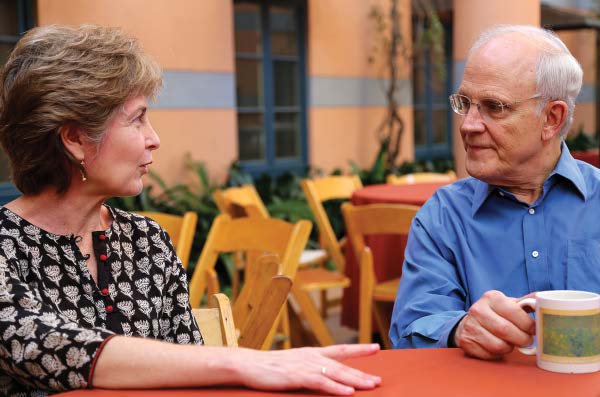 KITP Scholar Dimitra Karabali and Nobel Laureate David Gross discuss the finer points of physics.
KITP Scholar Dimitra Karabali and Nobel Laureate David Gross discuss the finer points of physics.
Photo by Spencer Bruttig.
You could call UC Santa Barbara’s Kavli Institute for Theoretical Physics (KITP) a kind of seaside physics resort. For physicists and the like, KITP is a treat for the mind, augmented by the beauty of the campus and near-perfect weather.
“I absolutely love the place,” said Janna Levin, associate professor of physics and astronomy at Barnard College in Manhattan and a KITP Scholar from 2010 to 2012. “I think it’s such an inspiring environment. I love the workshops and the open time for spontaneous collaboration, the chance just to talk and think and work out new possibilities.”
Celebrating its 35th anniversary, KITP is a pioneering scientific research facility where theorists in physics and allied fields congregate for sustained periods of time to work together intensely on a broad range of questions arising from investigations at the leading edges of science. The breadth of topics ranges from cosmology and biology to string theory, climate science and geophysics, as well as covering such traditional physics fields as condensed matter, particle physics, atomic physics, optics, turbulence and complexity.
The KITP Scholars program was established in 1998 by David Gross during his tenure as KITP director. One of six Nobel laureates at UCSB, Gross is a permanent member at KITP and a professor in the Department of Physics.
“I thought KITP was not taking advantage of its uniqueness or leveraging its possibilities,” Gross said. “My idea was to run a program where we could give physics professors with heavy teaching loads the opportunity to get the stimulation they need in order to continue their research careers. The KITP Scholars program has been more successful than I ever imagined.”
The program awards funds to cover a total of three visits and up to six weeks of local expenses to be used over a period of up to three years, usually two weeks per year. Approximately eight scholars are chosen each year, with a total of more than 100 awards to date.
One of the unique aspects of the KITP Scholars program is the fact that everyone is equal, whether they come from a graduate-degree-granting university or a primarily undergraduate institution. “Everyone is a visitor and nobody is asked to do anything except to interact and do physics and talk and lecture and learn,” Gross said. “It can be the scientific highlight of their year.”
“The KITP Scholars program addresses the needs of people in undergraduate institutions,” said Dimitra Karabali, professor in the Department of Physics and Astronomy at Lehman College, part of the City University of New York (CUNY). “Being faculty there can be challenging, because compared to major research universities, there is more teaching, more administrative duties and, most importantly, not enough research-active people to talk to.”
A KITP Scholar from 2000 to 2002, Karabali is in the middle of a second term (2013-2015). “Every time I visit KITP, it gives me an opportunity to hear new developments in my area, learn new techniques, interact with people and maybe get ideas for future projects,” she said.
Cross-pollination is at the heart of the KITP Scholars program. “One good thing about this place is its mixture of people doing different physics, so there is a lot of tolerance for questions,” said three-time KITP Scholar Peter Orland, a physics professor in the Department of Natural Sciences at CUNY’s Baruch College in Manhattan. “If I have a question or am working on a problem, I can ask people when I’m at KITP and get suggestions for resources that have the information I need. That actually happened on my last visit.”
Another early KITP Scholar, Herb Bernstein, a professor of physics at Hampshire College in Amherst, Mass., made such important connections at KITP and valued the experience so highly that he went on to help form a professional organization to promote research in all areas of theoretical and computational physics at primarily undergraduate institutions.
Formalized in 2007, the Anacapa Society provides networking opportunities and disseminates information to create, in effect, a large virtual department of theorists to support their distinctive role at undergraduate institutions. In recent years, the Anacapa Society has solicited applications for the KITP Scholars program, offering a small additional stipend and a dash of prestige to those chosen as the KITP Anacapa Scholar.
“Out of each workshop and each visit, at least one idea came to fruition and became a publication or a research program,” said Barnard College’s Levin. “There is no question that there were collaborations that began or were solidified at the KITP. It’s really in the collaborations that the magic happens.”
- Julie Cohen, UCSB Public Affairs & Communication
KITP Newsletter, Winter 2015
